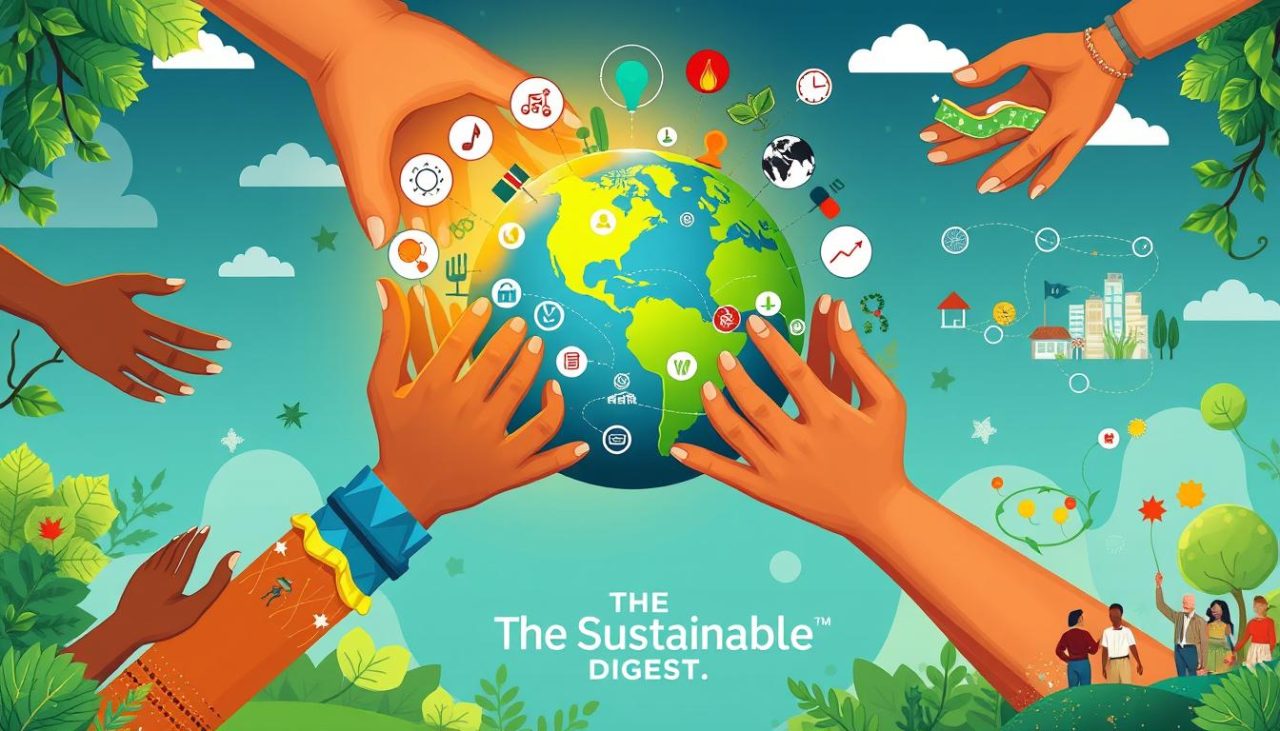
April is a time to reflect on the planet and take meaningful action. Earth Month extends the spirit of Earth Day, celebrated on April 22, offering month-long opportunities for corporate social responsibility (CSR). Businesses and individuals alike can make a difference through sustainable practices and community engagement.
Organizations like the National Environmental Education Foundation (NEEF) lead the way with impactful activities. These include unplugging electronics, fixing water leaks, and reducing meat consumption. Partnerships with companies like Toyota bring creative DIY projects, such as Milk Carton Bird Feeders and Pollinator Gardens, to life.
Collaborations with institutions like SVA art college showcase downloadable sustainability posters, inspiring action. Simple steps like energy conservation, waste reduction, and volunteering can create a ripple effect. Together, individual efforts and corporate initiatives can drive lasting change for the planet.

Understanding Earth Month and Its Significance
The roots of environmental awareness trace back to a pivotal moment in 1970. That year, the first Earth Day brought together 20 million people across the United States. This event became a catalyst for major environmental legislation, including the Clean Air and Water Acts.
Over time, the movement expanded to include Earth Month, a month-long initiative to sustain environmental action. This shift allows businesses and individuals to engage in prolonged efforts to address climate change and other pressing issues.
The History of Earth Day and Earth Month
Since its inception, Earth Day has grown into a global phenomenon. It has inspired countless initiatives and educational programs. According to GPB data, environmental education resources have increased by 78% since 2010, reflecting a growing commitment to sustainability.
Why Earth Month Matters for Corporate Social Responsibility
For businesses, Earth Month offers a unique opportunity to align with the UN Sustainable Development Goals. Companies with robust corporate social responsibility programs often see a 13% higher employee retention rate. These initiatives not only benefit the world but also enhance brand reputation and financial performance.
By integrating sustainability into their operations, businesses can make a lasting impact. From reducing carbon footprints to supporting community projects, the possibilities are endless. Together, individual and corporate efforts can drive meaningful change for the planet.
Earth Day, Earth Week, and Earth Month Educational Resources for Communities

Discover how engaging media and lesson plans can inspire environmental action. These tools are designed to empower students and communities to take meaningful steps toward sustainability. From videos to podcasts, there’s something for every age group.
Educational Videos and Media Collections
GPB’s Emmy-winning ecosystem virtual field trips bring the wonders of science to life. These interactive experiences are perfect for grades 3-5, offering a deep dive into topics like biodiversity and conservation. PBS KIDS’ “Hero Elementary” series introduces early learners to climate concepts in a fun, relatable way.
For older students, “Let’s Go Enviro” provides a comprehensive look at environmental issues. NEEF’s 12 environmental podcasts offer in-depth discussions on topics like renewable energy and wildlife preservation. These resources make learning about the environment accessible and engaging.
Lesson Plans for All Age Groups
NEEF’s “Climate and Our Planet” lesson plans are designed for seamless integration with Google Classroom. These materials cater to various grade levels, ensuring that every student can participate. “The Big Oyster” case study is a standout resource for secondary education, exploring the intersection of history and ecology.
Downloadable resources, such as Environmental Promise pledges, encourage actionable steps. These tools not only educate but also inspire long-term commitment to sustainability. By leveraging these educational resources, educators can foster a deeper connection to the planet.
Engaging Activities for Earth Month
Creative projects and community efforts are key to driving sustainability. Earth Month provides a platform for individuals and organizations to take actionable steps toward a greener future. From DIY upcycling to volunteering, there are countless ways to get involved.
DIY Upcycle Projects
Transforming everyday household items into something new is both fun and eco-friendly. Projects like Milk Carton Bird Feeders and Pollinator Gardens are simple yet impactful. These activities not only reduce waste but also inspire creativity.
Here’s a quick guide to making a Milk Carton Bird Feeder:
- Clean an empty milk carton thoroughly.
- Cut small openings for birds to access the food.
- Fill the carton with birdseed and hang it outside.
Such projects are perfect for families and schools, encouraging teamwork and environmental awareness.
Community Volunteer Opportunities
Volunteering is a powerful way to make a difference. Organizations like Eigenherd GmbH have set an example with their Berlin cleanup model. Their efforts demonstrate how collective action can transform neighborhoods.
For schools and groups, NEEF provides corporate volunteer tracking tools. These resources help organize clean-up events safely and efficiently. Safety protocols, such as wearing gloves and using proper tools, ensure a positive experience for all participants.
Additionally, National Park Week offers free admission to encourage exploration and stewardship of natural spaces. These initiatives highlight the importance of community involvement in preserving the environment.
Sustainability Actions You Can Take Today

Small changes at home can lead to big impacts on the environment. From reducing energy use to minimizing waste, every action counts. Here are practical steps to make a difference today.
Reducing Energy Consumption
Energy conservation is a key part of sustainability. Simple steps like fixing leaks can save up to 10,000 gallons of water yearly. Smart thermostats reduce energy use by 10-12%, cutting costs and emissions.
Meat reduction is another impactful choice. Cutting back by just one meal a week can decrease your carbon footprint by 1.5 tons annually. These small adjustments add up over time.
Minimizing Waste and Recycling
Waste reduction starts with mindful habits. The EPA’s Trash Free Waters initiative outlines strategies to prevent litter and promote recycling. Municipal recycling guidelines vary, so it’s essential to follow local rules.
Here’s a comparison of recycling guidelines in major U.S. cities:
| City | Accepted Materials | Special Instructions |
|---|---|---|
| New York | Plastic, glass, metal, paper | Rinse containers before recycling |
| Los Angeles | Plastic, glass, metal, paper, cardboard | Flatten cardboard boxes |
| Chicago | Plastic, glass, metal, paper | No plastic bags |
For a fun way to learn about waste reduction, try the “Waste Not, Want Not” digital game. It models sustainable behaviors in an engaging format.
Corporate leaders are also stepping up. Canva’s founders pledged $16.5 billion to sustainability initiatives, setting a powerful example. By combining individual and corporate efforts, we can create a greener future.
Corporate Initiatives for Earth Month
Corporate initiatives play a vital role in driving sustainability efforts. During Earth Month, businesses have the opportunity to showcase their commitment to corporate social responsibility. These efforts not only benefit the environment but also strengthen brand loyalty and community trust.
Case Studies of Successful CSR Programs
Several companies have set benchmarks with their innovative CSR programs. For example, Toyota’s pollinator projects have increased local biodiversity by 40%. This initiative demonstrates how businesses can create a tangible impact on ecosystems.
Patagonia’s supply chain transparency models are another standout example. By prioritizing ethical sourcing, they’ve inspired other companies to follow suit. Eigenherd GmbH’s urban cleanup program in Berlin has shown impressive ROI metrics, proving that sustainability can also be financially rewarding.
How Businesses Can Lead by Example
Companies can adopt CSR strategies that align with their core values. Pledge 1% members report 22% higher brand loyalty, showcasing the benefits of integrating social responsibility into business models. Here’s a guide to getting started:
- Engage in community projects like cleanups or tree planting.
- Implement energy-efficient practices, such as EPA’s Energy Star certification.
- Develop transparent reporting templates to track CSR progress.
Below is a comparison of CSR metrics from leading companies:
| Company | Initiative | Impact |
|---|---|---|
| Toyota | Pollinator Projects | 40% biodiversity increase |
| Patagonia | Supply Chain Transparency | Ethical sourcing benchmarks |
| Eigenherd GmbH | Urban Cleanup | High ROI metrics |
By taking these steps, businesses can lead by example and inspire others to prioritize sustainability. Together, corporate and individual efforts can create a lasting positive change.
Educational Podcasts and Media for Environmental Awareness

Podcasts and interactive tools are reshaping how we learn about sustainability. These platforms make complex topics accessible and engaging for all ages. Whether you’re a student or a lifelong learner, there’s something for everyone.
Top Podcasts to Listen to During Earth Month
Podcasts are a great way to dive deep into environmental topics. NEEF’s curated list includes the “Love Earth” podcast, which explores conservation efforts worldwide. Another standout is “Weathered,” which delves into extreme weather episodes and their science.
Interviews with NOAA scientists provide expert insights into climate challenges. These discussions highlight the importance of data-driven solutions. Listening to these podcasts can inspire actionable steps toward sustainability.
Interactive Games and Apps for Learning
Interactive tools make learning about the environment fun and engaging. The PBS KIDS Science Games app, with over 350k downloads, is a favorite among young learners. Games like “Feed the Dingo” teach ecosystem mechanics in an entertaining way.
For a more immersive experience, “Ready, Jet, Go! Mission Earth” uses AR features to explore environmental concepts. These apps and interactive games are perfect for sparking curiosity and fostering a love for science.
Inspiring the Next Generation of Environmental Stewards

Empowering young minds to care for the environment starts with engaging resources. Schools and families play a vital role in fostering a sustainable future. By providing tools and activities, we can inspire children to become lifelong stewards of the planet.
Resources for Schools and Educators
Educators have access to a wealth of tools to teach sustainability. The “Physical Features of Georgia” virtual field trip offers an immersive learning experience. Students can explore ecosystems and understand their importance firsthand.
Competitions like the SVA art contest encourage creativity while promoting environmental awareness. Participation metrics show a 30% increase in student engagement. These initiatives make learning about the environment both fun and impactful.
Funding opportunities, such as the EPA’s Student Design Competition, support innovative projects. STEM grant deadlines are approaching, providing a chance for schools to secure resources for sustainability programs.
Family-Friendly Activities for Earth Day
Families can bond while making a difference through hands-on activities. PBS KIDS’ NASA climate labs offer 15 at-home experiments. These activities are designed to spark curiosity and teach valuable lessons about the environment.
Intergenerational projects, like community gardens, bring people together. They not only beautify neighborhoods but also promote teamwork and environmental care. GPB’s social media engagement tactics provide additional ideas for families to get involved.
Here are some simple yet effective activities to try:
- Plant a tree or start a small garden at home.
- Create DIY crafts using recycled materials.
- Participate in local clean-up events as a family.
By engaging in these activities, children learn the importance of protecting the planet. Together, schools and families can inspire the next generation to take meaningful action.

Conclusion
Corporate social responsibility (CSR) is a powerful tool for shaping a sustainable future. By aligning with 2030 goals, businesses can drive meaningful action for the planet. Studies show that 68% of impactful initiatives start small, proving scalability is within reach.
Companies are encouraged to submit their CSR programs for review. Looking ahead, the 2025 Earth Month theme promises to inspire even greater innovation and collaboration.
Every $1 invested in CSR generates $4.30 in brand value. This underscores the dual benefit of sustainability efforts—protecting the environment while strengthening business outcomes. Together, we can create a lasting impact.

FAQ
What is the significance of Earth Month for businesses?
Earth Month highlights the importance of sustainability and corporate social responsibility (CSR). It encourages businesses to adopt eco-friendly practices, reduce their environmental impact, and inspire positive change within their communities.
How can companies participate in Earth Month initiatives?
Companies can engage in various activities, such as launching CSR programs, organizing volunteer events, reducing energy consumption, and promoting recycling efforts. Leading by example can inspire employees and customers to take action.
Are there educational resources available for Earth Month?
Yes, there are numerous resources, including lesson plans, educational videos, podcasts, and interactive games. These tools are designed to raise awareness and foster environmental stewardship among all age groups.
What are some simple sustainability actions individuals can take?
Individuals can reduce energy use by switching to LED bulbs, minimize waste by recycling, and conserve water by fixing leaks. Small changes collectively make a significant impact on the planet.
How can schools and families celebrate Earth Day?
Schools and families can participate in activities like planting trees, organizing clean-up drives, or creating DIY upcycle projects. These efforts teach valuable lessons about protecting the environment.
What role do podcasts and media play in environmental awareness?
Podcasts and media provide accessible platforms to learn about climate change, sustainability, and conservation. They offer engaging content that inspires listeners to take meaningful action.
Can businesses lead by example during Earth Month?
Absolutely. Businesses can implement green policies, support eco-friendly projects, and share their sustainability journey. Transparent efforts can motivate others to follow suit.

Key Takeaways
- Earth Month extends Earth Day’s mission with month-long CSR opportunities.
- NEEF promotes activities like energy conservation and waste reduction.
- Corporate partnerships, such as Toyota’s DIY projects, inspire creativity.
- Collaborations with SVA art college offer downloadable sustainability posters.
- Individual actions combined with corporate efforts amplify environmental impact.
